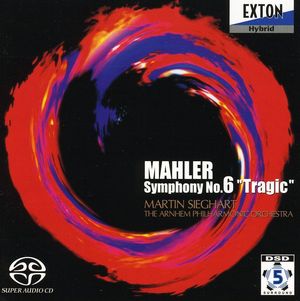I've been meaning to ask about Martin Sieghart's M6. Please tell us more. He was the guy who gave the world premiere performance of the Samale/Mazzuca performing version of Mahler 10, which I genuinely is the best overall version so far.
Barry

I am not a review writer and no expert in reading the score, so I will try to give some basic information and feelings about the M6 of Martin Sieghart/APO.
This M6-SACD was released in February 2007 even if the recording sessions date back to December 2003. Also the (P) and © dates are reported as 2004. The “Arnhem Philharmonic Orchestra” surely is not known very much and it is even more surprising, that the Exton label has produced a SACD with this orchestra and its (better known) chief conductor Martin Sieghart from Vienna. One reason for the Exton engagement might be given by the following facts: Arnhem was known as the base city of the Akzo chemical company. A part of Akzo went to the Japanese Teijin Group. I am mentioning this, since the record clearly is the most sponsored record I have ever seen. Not only that the second page of the booklet is devoted to the special fibre they make their money with, two additional pages list all others sponsors (repeating the top sponsor’s name here and there). Anyway, if this has made possible the connection to Exton and allowed to get T. Ezaki as recording director, then we want to see more CD’s with booklets full of sponsors.
I was curious about this record from the beginning but very sceptical regarding the timings (S/A order): 25:03 – 13:53 – 18:03 – 33:52.
This would be not only on the slower side, but the slowest M6 in my collection. Particularly the Andante takes much longer than usual. But finally my curiosity has won and I think its my best slow M6 up to now.
The first movement from the beginning shows one concept of the recording (my subjective opinion): control the marching, give space to all voices and show the colourfulness of Mahler’s music. The single bass notes of the march in the first two movements all have their own weight, are not simply a basic rhythm. It does not feel as slow as the timing indicates, but far away from faster approaches. At the end of the slower parts, in many approaches it’s like “the march strikes back” – a charging of power, which suddenly breaks through, driving forward with new power. That’s not the approach here. Even in the Finale it takes a while until these forces are totally released. I think it will depend on your taste and your mood what you prefer. Personally I often better like the driving force of this symphony, on such days I will surely not listen to this one.
However, the M6 – maybe more than the others – will never have THE best and most appropriate performance and concept. But it could be part of Sieghart’s approach to leave the fight between the two worlds of this symphony open as long as possible.
Consequently,the Scherzo shows no acceleration at the end, but also no slow down, it has the same tempo and control. The “Alma” parts of this symphony are played in a very detailed, colourful way (e.g. all woodwind parts), which is supported by the high-end sound. All voices and lines seem to be emphasized, many dynamic changes can be heard. By that even the slow Andante is more exciting than some faster performances.
The orchestra surely is playing at its edge, the clarity of sound seems to show anything (only in the crescendos I have some reservations, but this might be more a result of my amplifier than of the SACD).
There are nearly no reviews up to now, I only found this excerpt on the JPC page:
Stereoplay 05 / 07: "Die neue Mehrkanal-Produktion des Philharmonischen Orchesters von Arnheim mutet wie eine kleine Sensation an: Unter der präzisen Leitung von Martin Sieghart schafft sie nicht nur den Sprung zu den Referenzen des Katalogs, sondern bietet zudem eine audiophile Klangqualität, die selbst abgebrüht High-Endern den Atem rauben dürfte."
„The new multi-channel production of the APO looks like a small sensation. Under the precise direction of Martin Sieghart it does not only jump to the references in the catalogue, but delivers an audiophile sound quality, which might catch the breath of even hard-boiled high-enders.”
Michael